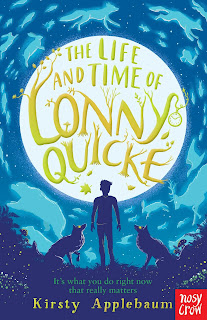Pub. Nosy Crow (May 2021)
Age Range - 9-12 years
Huge thanks to Nosy Crow for kindly sending me an ARC for review purposes! 😃
The Life and Time of Lonny Quicke tells the story of a
young boy with an extraordinary power. Lonny is a lifeling, and is able to restore life to
the dying; but, by lengthening the lives of other living things, he
shortens his own. Lonny is equally blessed and cursed.
To
my surprise, the novel foregoes the character's own discovery of this
power, launching us straight into the story. It makes for an altogether
more compelling opening. Kirsty Applebaum hits a perfect rhythm right from
the outset: she ends each chapter resolutely, but there's always
something to impel you to read one more, and one more, and one more.
It's truly masterful. Unsurprisingly, I read the entire book in a single, glorious sitting. I won't go into the themes here - these are discussed in the teaching ideas section below.
The novel is divided into three acts, and much of the action takes
place on the day of the town's annual lifeling festival, a parochial
event which actually brought me quite a sense of unease (perhaps because the songs and merriment gave me Summerisle vibes!). There are folktales which are told and retold, shaped and reshaped, and a keen reader will enjoy spotting the variance between them. The story has a quick pace, the characters are well developed, and the emotional beats are perfectly crafted. Thematically, the novel lends itself to class discussion, and offers some strong cross-curricular links.
Like Troofriend before it, The Life and Time of Lonny Quicke is an intelligent, emotional novel. As
an adult reader, it was sometimes easy to forget that it's a novel aimed
at children. Kirsty never dumbs down, presenting a story with depth and her trademark poignancy. This is a unique tale, the like of which could only come from the imagination of
Kirsty Applebaum, and which could only be given life by her delicate,
thoughtful touch.
teaching ideas
themes in the novel
These are some of the themes I was particularly drawn to (some spoilers here):
- Grief - Lonny wrestles
with the loss of his mother and longs to learn more about her.
- Depression - Lonny's father becomes angry and withdrawn, and there's a sense that he hasn't really dealt with the loss of Lonny's mother, concealing his feelings in much the same way that he conceals his sons.
- Confinement and isolation - there is mounting tension around Lonny and his confinement to the forest where he lives, and he quickly becomes frustrated with his (younger) brother, Midge, and his father.
- Sibling rivalry - Lonny frequently appears jealous of his brother's relative freedom and feels overshadowed by Midge's normalcy.
- Fear - Lonny's father and grandfather are deeply fearful of the inhabitants of the nearby town of Farstoke, feeling distrustful of their reaction to the discovery of Lonny's abilities, and of the fragility of Lonny's will to withhold his power.
- Freedom - Lonny is trapped within the confines of the forest, and repeatedly expresses a longing to explore the wider world.
- The passage of time - underpinning all of this, of course, is the theme of time itself. Time is shown to be fleeting, transitory, and there is a pervasive message that life is best lived in the moment. "It's what you do in the right now that really matters."
- Paranoia - for me, there was also a feeling of smalltown paranoia, but that might be because I've read a lot of Stephen King novels where this is a recurring motif! The sense of intimacy laced with a brooding danger in Farstoke put me in mind of Stephen King's Revival particularly.
in the classroom
There
are some important discussions to be had around the issues raised in the novel:
- The enduring agony of grief and loss underpin much of the story. There are clear PSHE/RE links here.
- The importance of life is another through line in the novel, leading us to ask ourselves if one life is worth more than another. Chapters 26 and 29 deal with this especially, but this again is something that runs through the whole book.
- The fragility and preciousness of life comes up again and again: the conversation between Lonny and Erin about mayflies in chapter 14 is just one example.
classroom resources
Coming soon!
